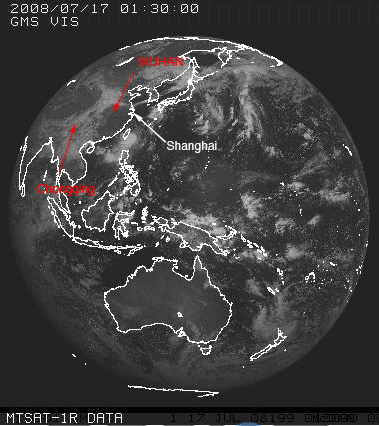|
Cette page utilise des informations fournies par Joe Cali et le cite.
«In attempting to familiarize myself with weather patterns and cloud movements over China in July I’ve created a series of animations to visualize it more easily. Cloud photos are courtesy of the Australian Bureau of Meteorology. This page began life as a review and planning tool. It was not originally intended for public consumption. As such the opinions expressed are those of Joe Cali and not the Australian Bureau of meteorology nor the Australian National University, Research School of Earth Sciences. It is however the readers responsibility to review all opinions on the weather and form their own observing strategy and I take no responsibilty for missed opportunities that result from reading opinions expressed on this page.»
All satellite images on this page are courtesy of and © Copyright Commonwealth of Australia 2009, Bureau of Meteorology (ABN 92 637 533 532).
|
Circuits en Chine :
Mer de Chine
[ Réserver ]
Circuits au Japon :
Iwo Jima
[ Réserver ]
Iles Marshall :
Enewetak
[ Réserver ]
|
|
2004
|

|

|

|
|
17 au 27 juillet 2004: fenêtre de 10 jours centrée sur l’éclipse
|
|
2005
|

|

|

|
|
17 au 27 juillet 2005: fenêtre de 10 jours centrée sur l’éclipse
|
|
2006
|

|

|

|
|
17 au 27 juillet 2006: fenêtre de 10 jours centrée sur l’éclipse
|
|
2007
|

|

|

|
|
17 au 27 juillet 2007: fenêtre de 10 jours centrée sur l’éclipse
|
|
2008
|

|

|

|
|
17 au 27 juillet 2008: fenêtre de 10 jours centrée sur l’éclipse
|
Follow the animation and look carefully. You will note that:
It is frequently clear in the south of Shanghai when it is quite cloudy at inland sites like Wuhan. Shanghai appears to be located in, for want of a better word, a cloud shadow. There must be some geographic reason for this.
There are very few days in any of the July 17-27 animations for the years 2004, 2007, 2008 (years chosen randomly) where it is clear inland while being cloudy in Shanghai. There are few tropical storm in the survey period.
I’d therefore conclude that while the chasers in Wuhan and other inland sites might want to run to Shanghai/Jinshan it is unlikely that Shanghai observers will gain any benefit from running inland except in the case of a tropical storm.
Analysis of cloud cover at the time of totality
The presence of cloud cover on such low resolution images is difficult to determine absolutely. However, I think this analysis makes a contribution to the overall picture of weather prospects.
I compiled the statistics in two ways. The percentage is the percentage of clear skies. In one set, I took the presence of scattered cloud to indicate a seen eclipse, i.e. that a mobile observer could in fact see the eclipse by finding a break in the cloud. In the other set I needed to see lots of dark pixels all around. Note that this data collation is subjective and that cloud can sometimes be seen on high resolution cloud photographs that is invisible on these low resolution photographs. High resolution photos are not presented here but can be reviewed at Dundee. Take out a membership for Quicklooks available at the Dundee Satellite receiving station and look at the IR with grid overlay images for these date ranges. July 17-27 for the years from 2004 to 2008.
|
2004
|
63
|
45
|
100
|
100
|
|
2005
|
81
|
72
|
72
|
72
|
|
2006
|
54
|
54
|
54
|
36
|
|
2007
|
63
|
27
|
90
|
90
|
|
2008
|
80
|
40
|
90
|
80
|
If we look at completely clear skies, then Shanghai is dramatically better than Wuhan in 3/5 years, equal in one and worse in one year.
Looking at scattered cloud data, Shanghai is slightly better in 3 years, equal in one year and slightly worse in one year.
Looking at the data and paying attention to relative conditions we get:
- When it is cloudy in Shanghai, it’s usually cloudy inland. 2006 is the exception to this rule (see 4).
- When it is cloudy inland, it is frequently clear in Shanghai.
- When a cyclonic tropical storm hits Shanghai, the cloud breaks up the day after landfall.
- When a cyclonic tropical storm hits Shanghai, it can push the cloud back away from Wuhan.
- There are few if any tropical storms present in the July 17-27 data sets.
- Chances of an eclipse being visible in very clear skies is greater in Shanghai that Wuhan.
- Chances of seeing an eclipse through broken cloud is more similar for Shanghai and Wuhan.
|















